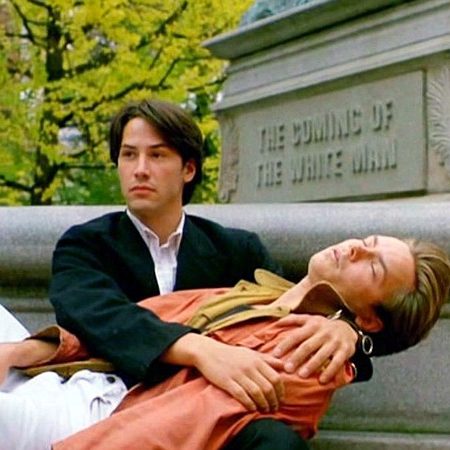
Watching Cameron Crowe’s Pearl Jam Twenty, I couldn’t escape the conclusion, based on Eddie Vedder, Jeff Ament, and Stone Gossard’s remarks, that the band thinks, “So, like, one of our best friends OD’d, we sent a tape to a surfer dude with a great voice, we jammed, and suddenly topless chicks at Lollapalooza were screaming ‘TEMPLE OF THE DOG!’ at us. Then things got complicated.”
Another example of his fascination with the privileged, artist-approved moment, Crowe’s discursive documentary eschews narrative — it avoids even a point of view. I don’t know what Pearl Jam “means” other than that they became reluctant avatars of grunge, reacted in part to the publicity by fighting a global leviathan, then — well, I’m not sure; among its other problems is no conclusion. Like Scorsese’s George Harrison, which elided the singer-guitarist’s most compelling paradoxes, Pearl Jam Twenty doesn’t even bother to follow the most conventional if reductive of narrative tricks: using biography to illuminate artistic creation. Why did Pearl Jam include an accordion-anchored dada exercise called “Bugs” on 1994’s Vitalogy? How did the band reconcile its punk and post-punk covers (Talking Heads! Dead Boys! Split Enz!) and producers (Mitchell Froom engineer Tchad Blake) and the studiousness with which it massaged classic rock tropes? The answer to a sympathetic non-fan like me is obvious: Pearl Jam took Neil Young’s ethos seriously. Despite five minutes of air time to the Mirrorball collaboration and an estimable if unsupported preface explaining how Seattle’s weather forced music devotees into loving classic rock, disco, New Wave, and pop with equal fervor, Crowe doesn’t even get Vedder or Gossard to admit that, if you’re a band whose collective record collection is so rich, then, to quote Young, it’s all one song. He will not allow for the possibility that in the last five years Pearl Jam has recorded their richest work; 2006’s eponymous album and 2009’s Backspacer are the sounds of fortysomething men with the confidence to winnow their influences into a recognizable, quietly weird stamp. Pearl Jam Twenty doesn’t document: it’s inept hagiography.

You just don’t get it. For a die-hard Pearl Jam fan, it was a beautiful film. http://afieldinwhichtofrolic.wordpress.com/2011/11/04/pearl-jam-twenty-what-it-means-to-me/
Fans should just die. Hard.
For the die hard fan such as myself, it didn’t need to be anything more than what it was. You mention “Bugs”, and while knowing the genesis of the track would be interesting, the same questions could be applied to countless other tracks in the PJ catalog. Why devote screen-time to a track that was only performed once, fifteen years after it appeared on Vitalogy? Because the die-hards this film appeals to know the answers to most of these questions. For me personally, I’ve collected countless bootlegs over the years. It was worth it alone just to put video and images to these shows I’ve listened to.
If the film were made for “die hards,” then Crowe should have send it to PJ’s fan club.
I liked the documentary, the nostalgic images and all, but my problem wasn’t so much that it “had no end” as the fact it felt like it WAS the end. It felt like old men reminiscing about this band they used to have. The eponymous album and “Backspacer” don’t even count? Crowe could have given it more of an “they’re still going on and being relevant” feel, but he didn’t. It made me me feel like Eddie Vedder had died or something.